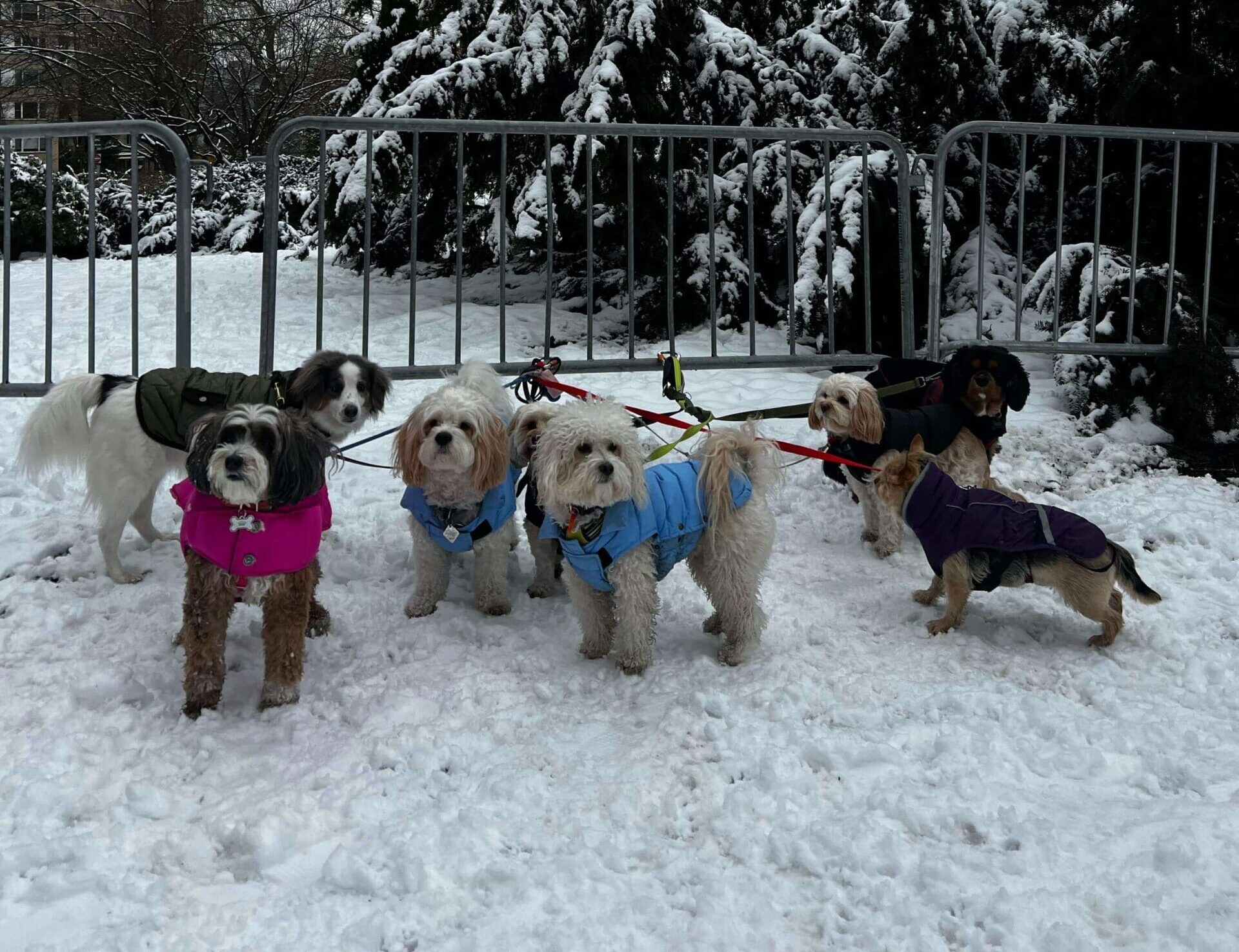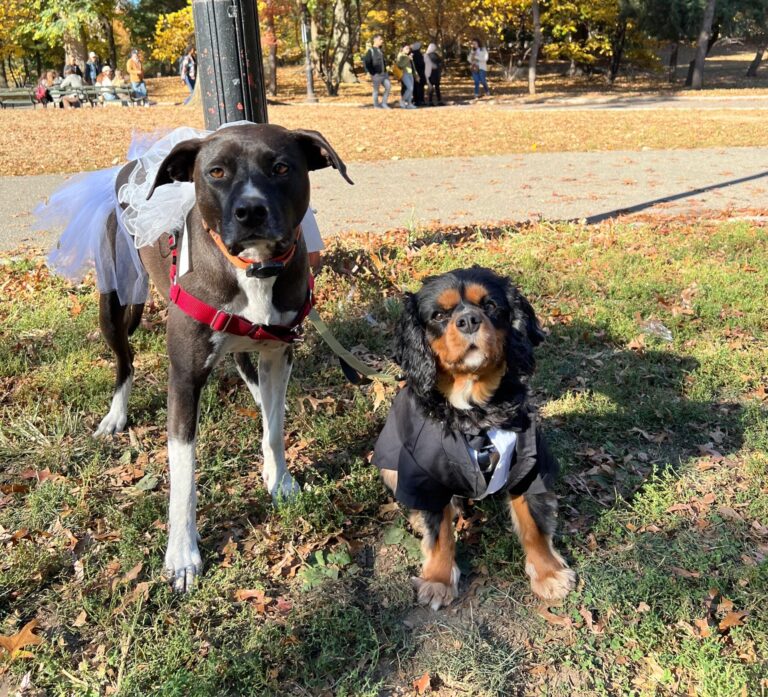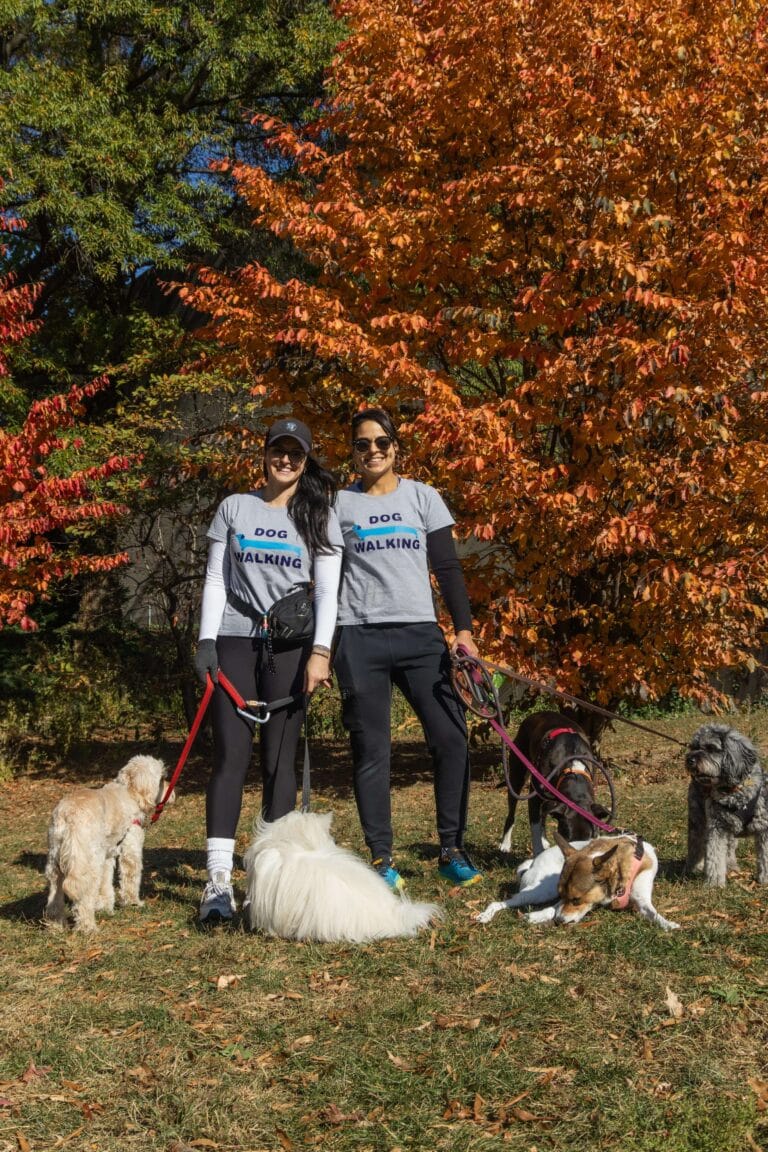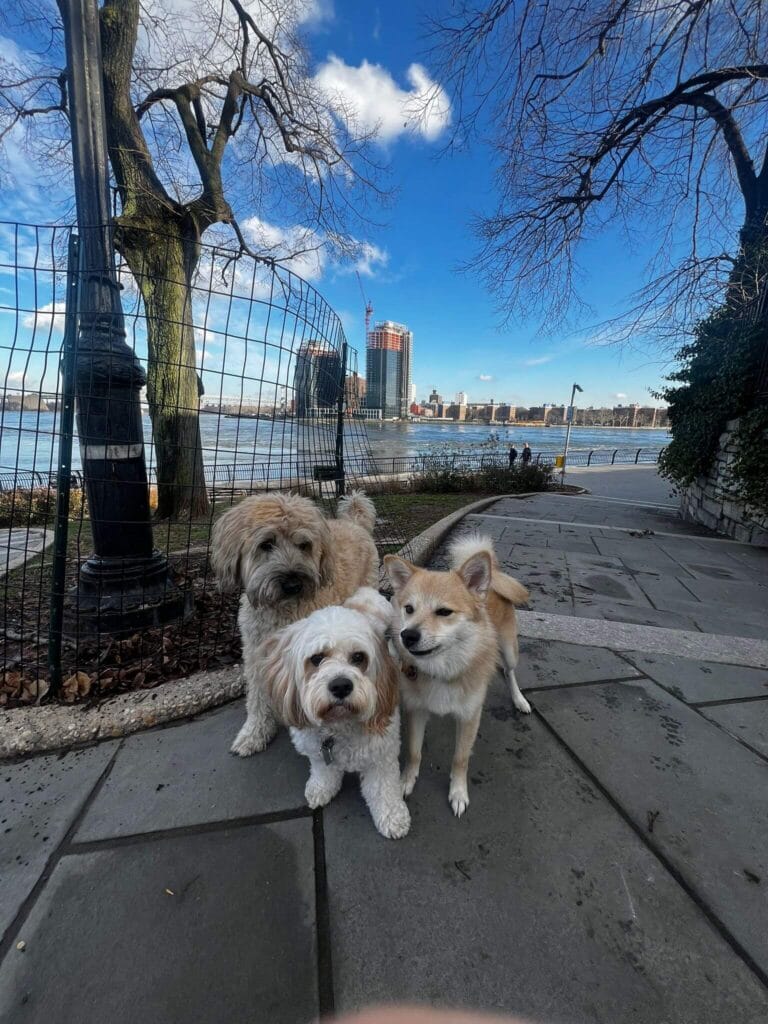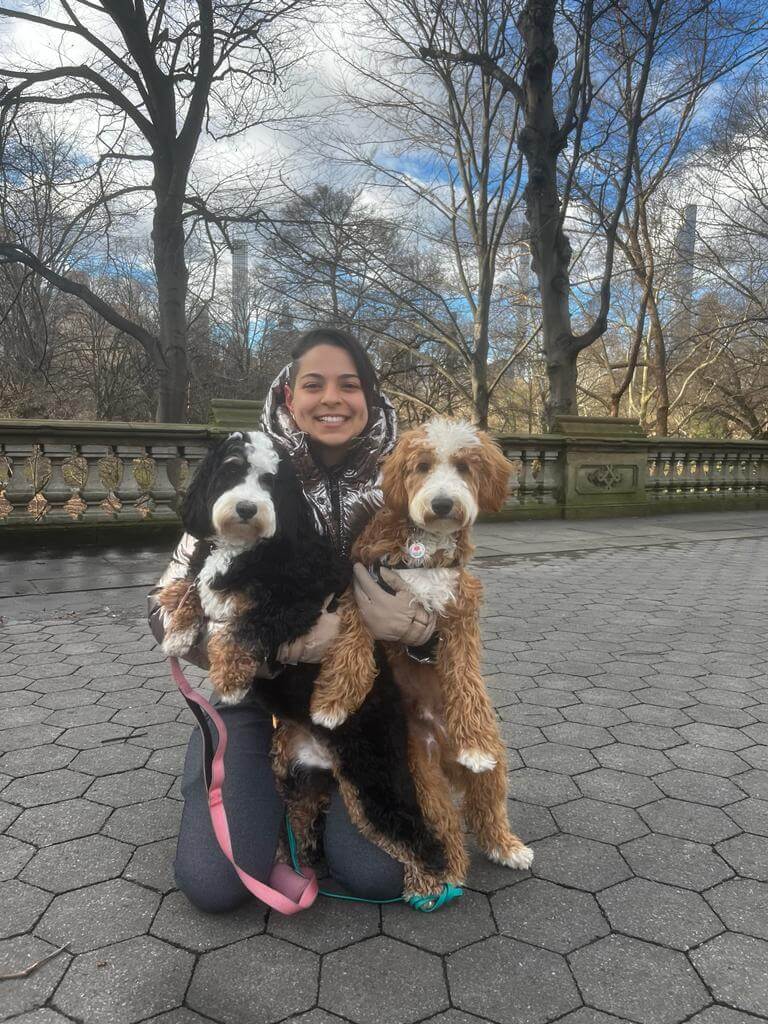Ever found yourself staring at your rain-soaked dog, both of you miserable on a January street corner in Chelsea? Yeah, me too. Manhattan’s weather doesn’t mess around, and neither should your dog walking strategy.
Your four-legged roommate needs those walks regardless of whether it’s 90 degrees or snowing sideways. Adapting dog walks for Manhattan’s seasons isn’t just smart—it’s essential for keeping your pup healthy and your sanity intact. To ensure your dog gets the best care year-round, consider reading Choosing the Best Dog Walker in NYC: A Comprehensive Guide for expert tips on selecting the right help.
As a Manhattan dog parent myself, I’ve learned the hard way that seasonal walking requires more than just grabbing whatever coat is by the door. I’ve got neighborhood-specific routes for August heatwaves and January blizzards alike.
But here’s what most dog owners get completely wrong about winter walking in particular…
Understanding Manhattan’s Seasonal Challenges
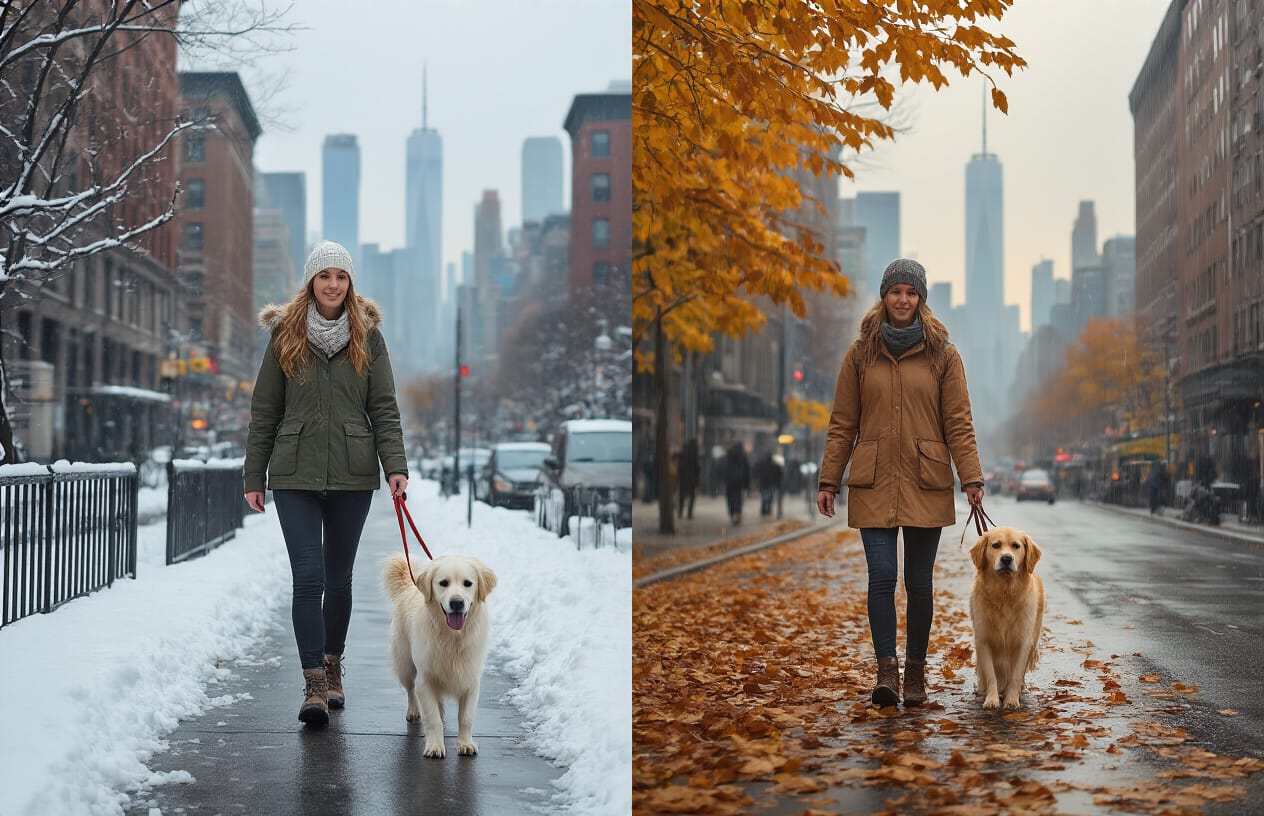
Weather Patterns That Impact Dog Walking
Manhattan’s weather isn’t just background noise—it directly affects how you and your pup experience those daily walks. Summer brings concrete that’s hot enough to burn paw pads (if you can’t hold your hand on the sidewalk for 7 seconds, it’s too hot for your dog). Then there’s winter, when temperatures plummet and sidewalks turn into salt-covered ice rinks.
Spring sounds perfect on paper, but those April showers create puddle-filled streets that your dog inevitably wants to splash through. And fall? Those gorgeous leaves hide all sorts of treasures your curious canine might try to eat.
The kicker is Manhattan’s microclimate effect—you might start a walk in sunlight and end up caught in a wind tunnel between skyscrapers that drops the temperature 10 degrees. For deeper insights into urban microclimates and their effects on daily life, Weather.com offers detailed articles and forecasts.
Seasonal Hazards for Urban Dogs
Manhattan dogs face unique seasonal challenges. Summer brings dehydration risks and scorched paws, but also the delightful surprise of sidewalk trash baking in 90-degree heat. For expert advice on preventing heat-related illnesses in pets, the ASPCA offers comprehensive guidelines.
Winter introduces antifreeze puddles (deadly if licked) and rock salt that both burns paws and causes stomach issues if ingested. Your dog’s tolerance changes too—breeds with thick coats might thrive in January but struggle in July.
Spring and fall have their own sneaky problems:
- Seasonal allergies that make your dog itchy and uncomfortable
- Mushrooms sprouting in parks after rain
- Increased rodent activity as temperatures change
- More crowded sidewalks during pleasant weather
Benefits of Adapting Your Walk Routine
Changing your walking strategy with the seasons isn’t just nice—it’s necessary for your dog’s wellbeing. Dogs who get appropriate exercise regardless of weather tend to have fewer behavioral issues and maintain healthier weights. Not sure how to structure your pup’s routine? Our guide on Private vs. Group Dog Walks: Which is Right for Your NYC Pup? can help you choose the best option for every season.
Adaptation also means less stress for you. Nothing ruins a day faster than a half-mile walk turning into a nightmare because you weren’t prepared for the conditions.
The best part? Seasonal adaptations create new bonding experiences. That winter indoor training session or summer morning park visit before the heat hits becomes special time together. Your dog learns to trust you as their consistent provider regardless of what Mother Nature throws at Manhattan.
By adjusting routes, timing, and gear with the seasons, you’re not just surviving Manhattan’s weather extremes—you’re helping your dog thrive through them.
Spring Walking Strategies
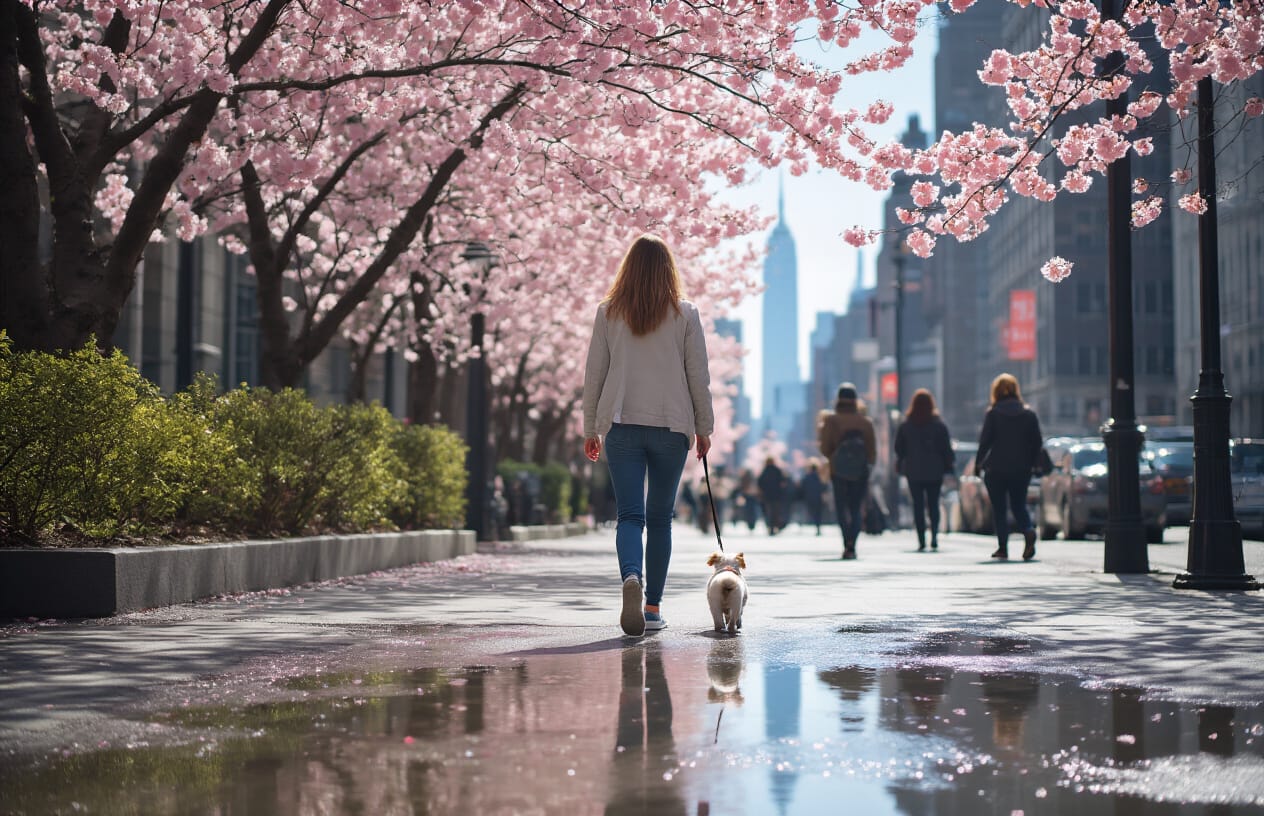
A. Navigating Rainy Days and Muddy Parks
Spring in Manhattan means unpredictable rain showers and muddy park conditions. I’ve learned the hard way that an unprepared dog walk can turn into a messy disaster.
Pack a small microfiber towel in your pocket – trust me, you’ll thank yourself when your pup decides to splash through every puddle on 5th Avenue. And those paw wipes? Not just a fancy accessory. They’re absolutely essential for quick clean-ups before heading back into your apartment.
Some Manhattan dog parents swear by those rubber booties, but let’s be real – most dogs hate them. A simpler trick? Apply a thin layer of paw balm before walks. It creates a barrier against muddy irritants and washes off easily.
When it’s pouring? Skip the crowded covered areas in Central Park where every dog owner flocks. Instead, try the covered walkways near the Museum of Natural History or the sheltered paths along Battery Park – way fewer crowds, and your pup still gets their exercise.
B. Protecting Your Dog from Seasonal Allergies
Spring allergies don’t just torture humans in Manhattan – our dogs suffer too. The symptoms aren’t always obvious: excessive paw licking, ear scratching, or sudden sneezing fits might be your first clues. For reliable information on allergies and pet health, the CDC offers useful resources.
The city’s blooming trees are gorgeous but brutal on sensitive pups. After walks, wipe down your dog’s coat and paws immediately. This simple step removes pollen before it can spread all over your apartment and cause more reactions.
High pollen days (you can check the count on weather apps) call for shorter walks and alternative indoor exercise. A quick game of tug in your apartment beats an hour of misery outside.
Talk to your vet about appropriate antihistamines for those really bad allergy days. Some Manhattan vets recommend specific supplements that strengthen the immune system during spring months.
C. Best Spring Routes with Blooming Scenery
The spring transformation of Manhattan’s parks is nothing short of magical, and knowing the perfect routes makes all the difference.
The eastern path in Central Park near the Conservatory Garden offers spectacular cherry blossoms in April without the tourist crowds you’ll find at the popular spots. For even more ideas, check out the Top Dog Walking Routes in Manhattan’s Upper East Side—a curated list of neighborhood gems perfect for spring strolls with your pup.
Bryant Park’s perimeter walkway features incredible tulip displays from mid-April through May. The bonus? Most of the path is paved, meaning less mud on those post-rain walks.
For something different, the High Line in spring is dog-walking heaven. The elevated park’s carefully curated plantings look stunning as they wake up from winter, and the limited entry points mean fewer unexpected encounters with dogs that might not be as friendly as yours.
Riverside Park’s cherry walk section offers both river breezes and gorgeous blooms. The wide pathways mean you won’t be constantly crossing paths with runners and cyclists like in some other parks, making it ideal for peaceful strolls that highlight The Health Benefits of Regular Dog Walking in Manhattan NYC.
Summer Heat Management
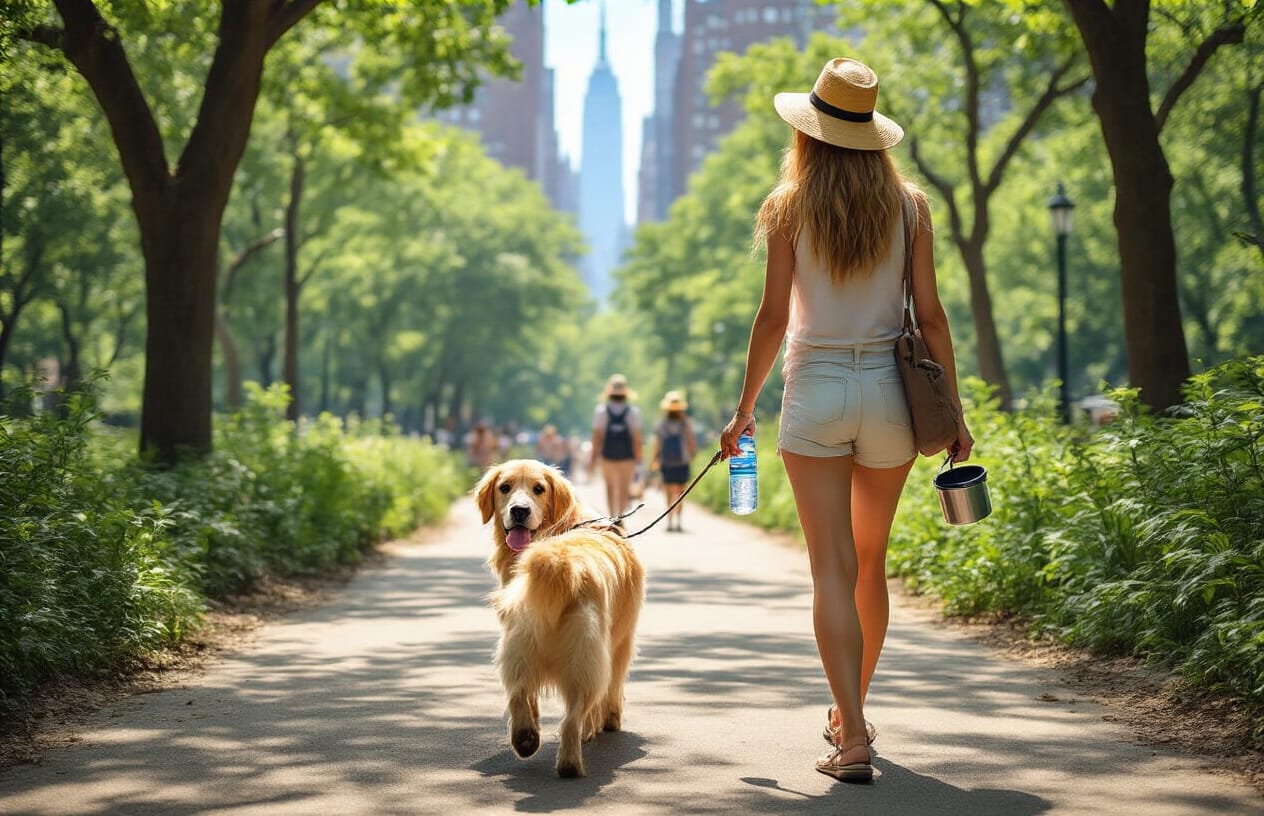
Early Morning and Evening Walking Benefits
Manhattan summers are brutal. The concrete jungle absorbs heat like nobody’s business, turning your normal dog walking routine into a potential health hazard.
Taking your pup out before 8am gives you both breathing room. The concrete hasn’t had time to heat up, the air still has that slight morning crispness, and you’ll actually enjoy the experience—especially if you’re using a reliable dog walking service in the Upper East Side NYC that understands how to adjust routines to beat the summer heat.
Evening walks after 7pm offer similar advantages. The sun’s intensity drops dramatically, and you might even catch a pleasant breeze between the buildings. Plus, your dog gets to experience the city winding down – different smells, different energy.
Bonus? You’ll encounter fewer tourists blocking sidewalks during these off-peak hours.
Finding Shaded Routes and Water Spots
Smart Manhattan dog parents know the shaded routes by heart. Central Park’s Ramble offers dense tree coverage when the sun’s blazing. The High Line has strategic spots where buildings block direct sunlight during specific hours.
Water spots are your secret weapon:
| Location | Water Features | Best Times |
|---|---|---|
| Madison Square Park | Dog fountain | Mornings |
| Carl Schurz Park | Water stations | Afternoons |
| Battery Park | Harbor breezes | Evenings |
Many cafes and stores put water bowls outside during summer months. Map these spots mentally for emergency cool-downs.
Pavement Temperature Awareness
The “back of hand” test saves paws. Press your hand against the pavement for 7 seconds. If it’s too hot for your hand, it’s definitely too hot for your dog’s sensitive paw pads.
Asphalt can reach 140°F when air temperatures hit just 87°F. At those temperatures, tissue damage happens in 60 seconds of contact.
Consider protective booties for your pup, especially if they’re not fans of grass walking. They might look silly prancing around in little shoes, but burned paws take weeks to heal and cause serious pain.
Stick to concrete when possible – it gets hot but not as blazing as darker surfaces like asphalt.
Fall Walking Delights
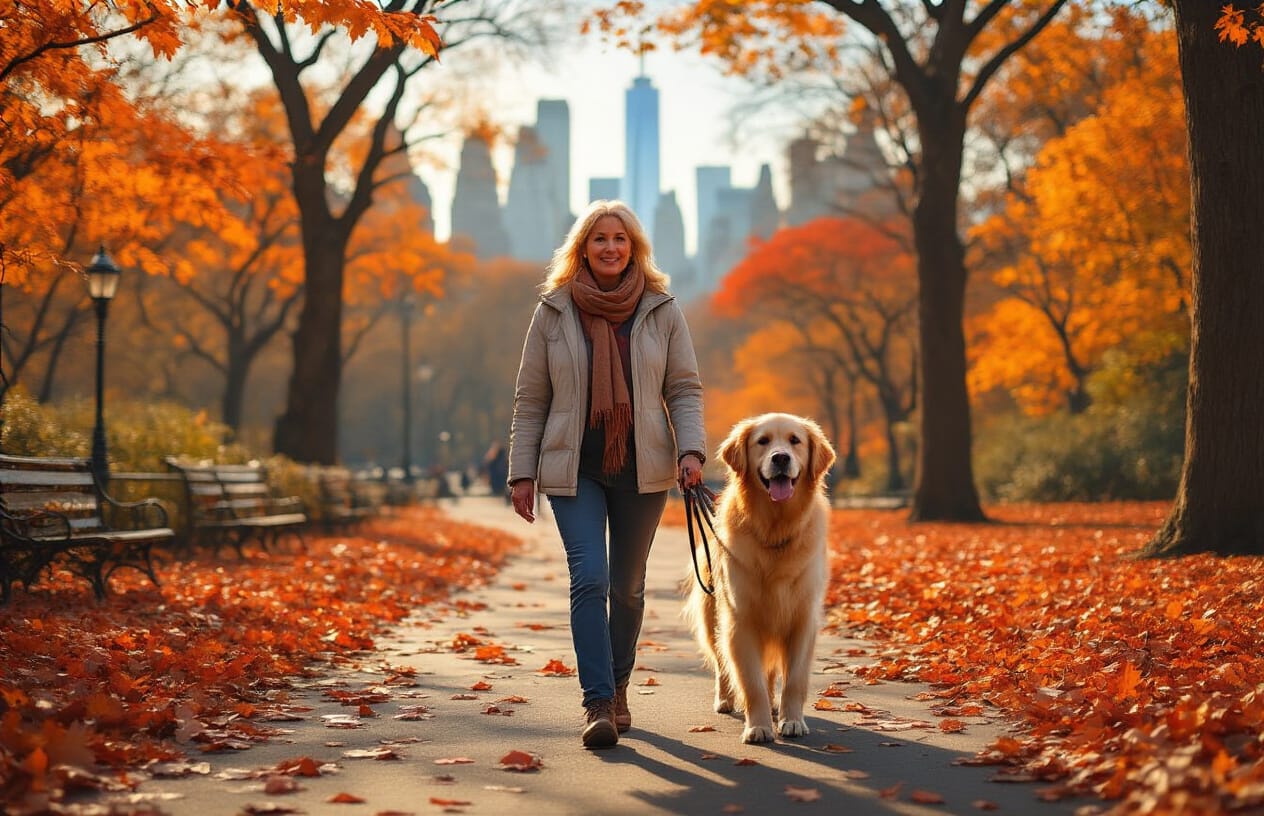
A. Leaf-Peeping Routes in Manhattan
Manhattan transforms into a kaleidoscope of colors come fall. Trust me, your dog will love these sensory adventures as much as you will.
Central Park is the crown jewel of fall walking. The Mall’s elm-lined pathway creates a golden canopy that’ll have you stopping for Instagram pics every few steps. Your pup will love crunching through fallen leaves while you soak in the views. To keep your dog’s routine balanced during these beautiful walks, check out How Often Should Your Dog Be Walked in Manhattan? for expert advice on the perfect frequency and duration.
Riverside Park offers a more peaceful alternative with stunning Hudson River views framed by fiery maples and oaks. The pathway between 91st and 96th streets is particularly gorgeous when the morning light hits just right.
Fort Tryon Park is worth the uptown trek. The hemlocks and oaks create a breathtaking display, and the elevation gives you panoramic views of the Hudson with Jersey’s fall foliage across the water. Talk about a two-for-one leaf-peeping experience!
B. Adjusting to Shorter Daylight Hours
Early darkness catches many Manhattan dog parents off guard. One day you’re enjoying 8 PM walks in sunshine, the next you’re fumbling for your phone flashlight at 5:30.
Morning walks become your best friend in fall. Grab that first light – it’s golden, less crowded, and gives your pup exercise before you both tackle the day.
Safety becomes non-negotiable. Reflective gear isn’t just smart, it’s essential. For more tips on navigating high-traffic areas with confidence, check out Staying Safe: Dog Walking Tips for Busy NYC Streets—it’s packed with practical advice for protecting your pup on Manhattan’s most hectic sidewalks.
Adjust your walking schedule gradually. Dogs thrive on routine, so shift walks 15 minutes earlier every few days rather than making dramatic changes that confuse your furry friend.
C. Weather-Appropriate Gear for Fluctuating Temperatures
Fall in Manhattan is notoriously fickle – 70°F at noon, 45°F by your evening walk. Layering saves the day for both of you.
For shorter-haired breeds, consider a light doggy sweater for morning walks when there’s still that overnight chill. Nothing fancy needed – just enough to take the edge off until the day warms up.
Your walking kit should include:
- A packable water-resistant jacket (for you)
- Portable dog towel (wet leaves = muddy paws)
- Collapsible water bowl (dogs still get thirsty in cooler weather)
- Poop bags (always, always, always)
Those fancy boots for dogs? Most Manhattan pups don’t need them in fall, but they’re worth considering if your walks include areas treated with early de-icing chemicals.
Don’t forget a treat pouch! Fall brings new distractions – squirrels frantically gathering nuts will test even the best-trained dog’s focus.
Winter Walking Survival Guide
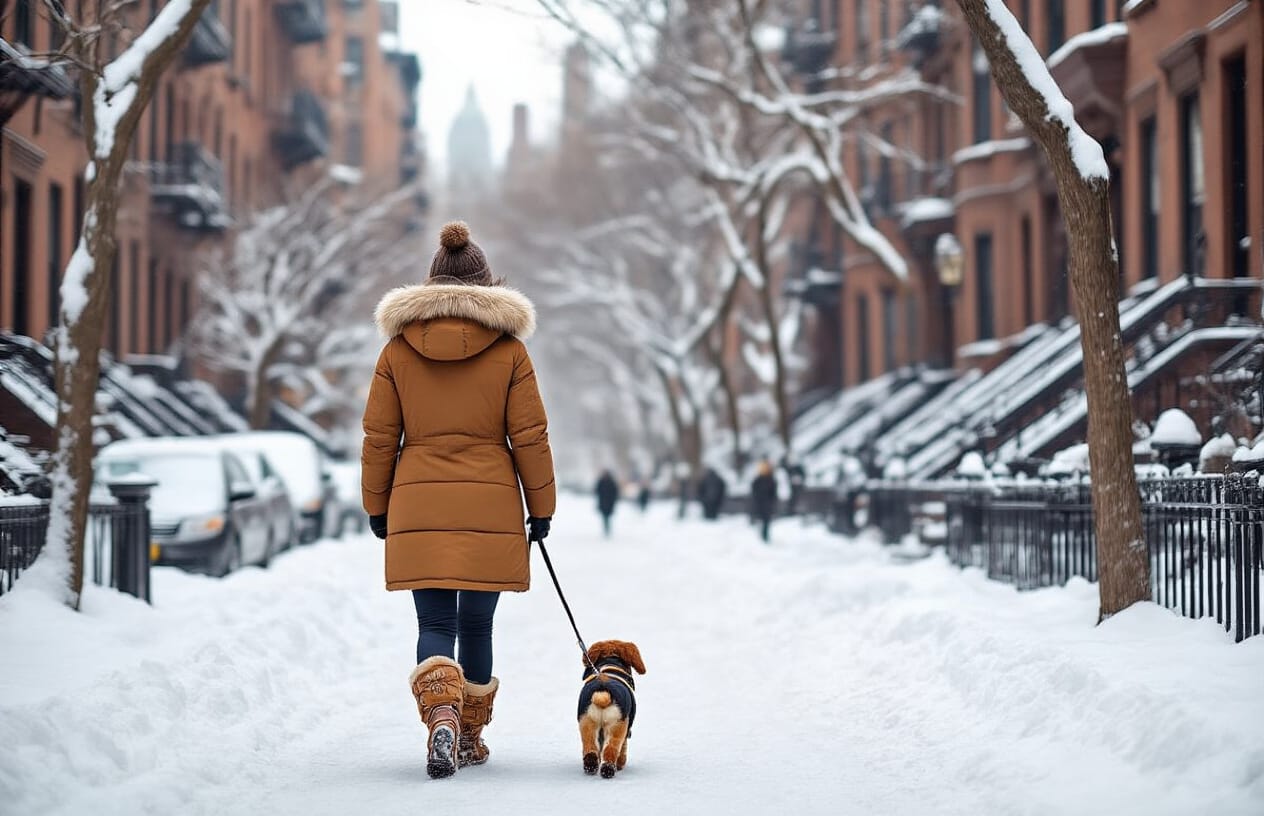
Protecting Paws from Salt and Ice
Winter in Manhattan is brutal on your dog’s paws. That sidewalk salt? It burns like crazy. Those ice chunks? They cut paw pads like tiny knives. To help protect your pup, don’t miss our full checklist of Essential Gear for Dog Walks in NYC—you’ll find the best paw balms, boots, and other cold-weather must-haves.
Here’s what actually works:
- Musher’s Secret: This paw wax creates an invisible barrier. Apply before walks, and salt bounces right off.
- Booties: Yeah, your dog will walk funny at first. Hilarious videos aside, they’re the best protection. Get ones with rubber soles and velcro straps that actually stay on.
- Post-walk rinse: Keep a bowl of warm water by your door. Dip each paw when you get home – it dissolves salt instantly.
Don’t skip this routine. I’ve seen too many Manhattan dogs limping by February because their owners thought paw care was optional. For expert advice on protecting your dog’s paws during winter, check out the American Kennel Club (AKC).
Cold-Weather Clothing for Different Breed Types
Manhattan winters demand different protection depending on what kind of dog shares your apartment:
Short-haired breeds (Pit Bulls, Greyhounds): They’re freezing. Period. Get insulated jackets that cover their chest and belly, not just their back.
Small dogs (Chihuahuas, Yorkies): Their bodies hover close to freezing sidewalks. They need full-body coverage plus the aforementioned booties.
Thick-coated breeds (Huskies, Samoyeds): They’re built for this weather but still need paw protection. Skip the coats unless it’s below 20°F.
Senior dogs: Older joints ache in cold. Invest in thermal wraps specifically designed for arthritic dogs.
The “my dog has fur” excuse doesn’t cut it when it’s 15 degrees with windchill funneling between skyscrapers.
Indoor Exercise Alternatives During Extreme Weather
When polar vortexes hit or when sleet is pelting sideways, sometimes staying in is the only option. But a bored Manhattan dog is a destructive Manhattan dog. For creative indoor exercise ideas that keep your dog active, PetMD has a great selection of expert tips.
Try these apartment-friendly alternatives:
- Stairwell sprints: If your building allows it, stair running burns massive energy in minimal time.
- Hallway fetch: Early morning or late night, those long hallways become perfect fetch runways.
- Nose work games: Hide treats throughout your apartment. Mental stimulation tires dogs as effectively as physical exercise.
- Tug stations: Set up designated spots for intense tug sessions that won’t knock over your furniture.
- Training circuits: Five minutes each of sit-stays, downs, recalls, and tricks creates a 20-minute workout.
Remember, a Manhattan dog denied exercise becomes an expert in creative destruction. Your shoes, couch, and sanity depend on providing alternatives when winter weather makes walks impossible.
Conclusion
Navigating Manhattan’s diverse seasons requires thoughtful adaptation of your dog walking routine. From spring’s unpredictable weather and summer’s scorching pavements to fall’s pleasant conditions and winter’s harsh elements, each season demands specific strategies to keep your furry friend safe and happy. Remember to adjust walking times, pack appropriate gear, and be mindful of your dog’s unique needs as the weather changes.
The joy of walking your dog in Manhattan remains constant throughout the year when you’re properly prepared. Take advantage of the city’s many dog-friendly parks, indoor facilities during extreme weather, and professional walking services when needed. By following seasonal guidelines and utilizing available resources, you and your canine companion can enjoy safe, comfortable walks in every season the city has to offer.
Ready to make every walk a safe and joyful experience for your dog? Contact Andreia’s Dogs—Manhattan’s trusted pet care experts—to tailor your dog walking routine to the seasons and keep your pup happy all year long. Schedule a meet-and-greet today!
Frequently Asked Questions (FAQs)
The best times are early morning and late evening, when temperatures are cooler and pavement is less likely to burn your dog’s paws. Avoid midday walks, especially between 11 a.m. and 4 p.m., when the sun is strongest. Always carry water and take breaks in shaded areas to prevent overheating.
Use dog booties or paw balm to shield against ice, salt, and cold surfaces. Always wipe your dog’s paws after a walk to remove irritants. Consider trimming the fur between their pads to reduce ice buildup. If your dog refuses booties, apply balm like Musher’s Secret before and after each walk.
Yes. Pet-friendly indoor spaces like certain stores, lobbies, or indoor dog parks can be great options during extreme cold, heat, or storms. You can also create short enrichment walks inside your building using stairs or hallways. Interactive games and indoor training exercises can help burn energy on days when outdoor walks aren’t safe.
Watch for signs like shivering, limping, or lifting paws in the cold—or excessive panting, drooling, or lethargy in the heat. Adjust accordingly. Each breed has different tolerances, so monitor changes in behavior closely. When in doubt, shorten the walk and observe your dog for any post-walk discomfort.
Absolutely. Dogs can develop allergies to pollen, grass, and other environmental factors. Spring and fall are the most common allergy seasons. Symptoms include scratching, licking paws, watery eyes, and sneezing. A vet can recommend antihistamines or dietary changes to help manage your dog’s symptoms.

